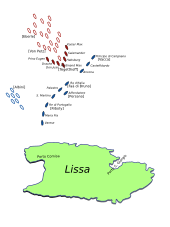Italian ironclad Terribile
 Terribile in Naples in 1869
| |
| History | |
|---|---|
| Name | Terribile |
| Laid down | June 1860 |
| Launched | 16 February 1861 |
| Completed | September 1861 |
| Stricken | 1904 |
| Fate | Broken up |
| General characteristics | |
| Class and type | Formidabile-class ironclad warship |
| Displacement |
|
| Length | 65.8 m (215 ft 11 in) |
| Beam | 14.44 m (47 ft 5 in) |
| Draft | 5.45 m (17 ft 11 in) |
| Installed power |
|
| Propulsion |
|
| Speed | 10 knots (19 km/h; 12 mph) |
| Range | 1,300 nmi (2,400 km) at 10 kn (19 km/h; 12 mph) |
| Complement | 371 |
| Armament |
|
| Armor | Belt armor: 109 mm (4.3 in) |
Terribile was the first
The ship took part in the operation off Lissa in 1866 during the Third Italian War of Independence. There, was tasked with neutralizing the Austrian coastal batteries protecting the port at Comisa, which placed her too far away to take part in the ensuing Battle of Lissa. The ship's postwar career was limited due to a combination of drastically reduced naval budgets and the appearance of more modern ironclads. In 1885, Terribile was withdrawn from service for use as a training ship. She remained in service until 1904 when she was broken up for scrap.
Design
Terribile was 65.8 meters (215 ft 11 in)
Terribile was a
Service history
Terribile was built by the
Rear Admiral Wilhelm von Tegetthoff brought the Austrian fleet to Ancona on June 27, in attempt to draw out the Italians. At the time, many of the Italian ships were in disarray; Terribile was carrying only half her guns at the time, and other ships were experiencing various difficulties with their engines or armament. Persano held a council of war aboard the ironclad Principe di Carignano to determine whether he should sortie to engage Tegetthoff, but by that time, the Austrians had withdrawn, making the decision moot. The Minister of the Navy, Agostino Depretis, urged Persano to act and suggested the island of Lissa, to restore Italian confidence after their defeat at the Battle of Custoza the previous month. On 7 July, Persano left Ancona and conducted a sweep into the Adriatic, but encountered no Austrian ships and returned on the 13th.[5]
Battle of Lissa

On 16 July, Persano took the Italian fleet out of Ancona, bound for Lissa, where they arrived on the 18th. With them, they brought troop transports carrying 3,000 soldiers; the Italian warships began bombarding the Austrian forts on the island, with the intention of landing the soldiers once the fortresses had been silenced. In response, the Austrian Navy sent the fleet under Tegetthoff to attack the Italian ships.
Persano repeated his orders for the 20th, with Terribile and Varese again tasked with suppressing the batteries at Comisa. Before the Italians could begin the attack, the
Terribile did not see action during the battle; she only fired a single long-range shot at the ship of the line Kaiser.[9] She had answered Persano's summons very slowly and only arrived on the scene after Re d'Italia had been rammed and sunk, and the coastal defense ship Palestro had been set on fire, soon to be destroyed by a magazine explosion. Persano's forces had withdrawn, and though his ships still outnumbered the Austrians, Persano refused to counter-attack. The Italian fleet began to withdraw, followed by the Austrians; as night began to fall, the opposing fleets disengaged completely, heading for Ancona and Pola, respectively.[10]
Later career

After the battle, Persano was replaced by Admiral
By October 1871, Terribile had been stationed in
Notes
- ^ a b c Fraccaroli, p. 337.
- ^ Fraccaroli, pp. 334–335, 337.
- ^ Sondhaus 1994, p. 1.
- ^ Greene & Massignani, pp. 217–222.
- ^ Wilson, pp. 216–218.
- ^ Sondhaus 1994, pp. 1–2.
- ^ Wilson, pp. 219–223.
- ^ Wilson, pp. 223–225, 231–233.
- ^ Greene & Massignani, p. 230.
- ^ Wilson, pp. 238–241, 250.
- ^ Wilson, p. 251.
- ^ Fraccaroli, p. 336.
- ^ Sondhaus 2001, p. 112.
- ^ Dupont, p. 426.
- ^ "The Storm at Naples". The Times. No. 27565. London. 20 December 1872. col D, p. 7.
- ^ Ordovini, Petronio, & Sullivan, p. 328.
References
- Dupont, Paul, ed. (1872). "Notes sur La Marine Et Les Ports Militaires de L'Italie" [Notes on the Navy and Military Ports of Italy]. La Revue Maritime et Coloniale [The Naval and Colonial Review] (in French). XXXII. Paris: Imprimerie Administrative de Paul Dupont: 415–430.
- Fraccaroli, Aldo (1979). "Italy". In Gardiner, Robert (ed.). Conway's All the World's Fighting Ships 1860–1905. London: Conway Maritime Press. pp. 334–359. ISBN 978-0-85177-133-5.
- Greene, Jack; Massignani, Alessandro (1998). Ironclads at War: The Origin and Development of the Armored Warship, 1854–1891. Pennsylvania: Da Capo Press. ISBN 978-0-938289-58-6.
- Ordovini, Aldo F.; Petronio, Fulvio & Sullivan, David M. (December 2014). "Capital Ships of the Royal Italian Navy, 1860–1918: Part I: The Formidabile, Principe di Carignano, Re d'Italia, Regina Maria Pia, Affondatore, Roma and Principe Amedeo Classes". ISSN 0043-0374.
- Sondhaus, Lawrence (1994). The Naval Policy of Austria-Hungary, 1867–1918. West Lafayette: Purdue University Press. ISBN 978-1-55753-034-9.
- Sondhaus, Lawrence (2001). Naval Warfare, 1815–1914. New York: Routledge. ISBN 978-0-415-21478-0.
- OCLC 1111061.
External links
- Terribile Marina Militare website (in Italian)
